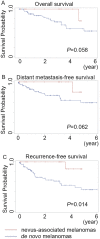Clinicopathological features and prognosis of patients with de novo versus nevus-associated melanoma in Taiwan
- PMID: 28472158
- PMCID: PMC5417671
- DOI: 10.1371/journal.pone.0177126
Clinicopathological features and prognosis of patients with de novo versus nevus-associated melanoma in Taiwan
Abstract
Studies surveying melanomas associated with melanocytic nevi in Asia are rare. In this study, we examined whether nevus-associated melanomas differ from de novo melanomas in terms of their associations with clinical factors, histologic characteristics, and patient survival in Taiwan. Using data on cancer cases obtained from the Department of Pathology archives and the Cancer Registry of National Taiwan University Hospital, we conducted a retrospective analysis of 103 consecutive melanoma patients who were diagnosed between 2010 and 2015 and received follow-up through November 2016. Approximately 17.5% of the melanomas in question were associated with a nevus. In patients under 65 years of age, non-acral lentiginous melanomas were significantly associated with a higher percentage of nevus-associated melanomas. The superficial spreading subtype, younger patient age, thinner tumor, intermittent solar exposure, and early stage were significant predictors of a melanoma being histologically associated with a nevus. The appearance of a nevus associated with a melanoma predicted better recurrence-free survival compared with de novo melanomas. Although acral lentiginous melanomas (70.9%) constituted the most common histologic subtype, only 9.6% of the acral lentiginous melanomas were associated with a nevus. Furthermore, there was no statistically significant difference between the nevus-associated and de novo acral lentiginous melanomas with regard to clinicopathological factors and survival. In conclusion, nevus-associated melanomas were uncommon among acral lentiginous melanomas. Relatedly, because over half of all melanomas in Asians are acral lentiginous melanomas, Asians are less likely than Caucasians to have nevus-associated melanomas.
Conflict of interest statement
Figures



References
-
- Ackerman AB. What naevus is dysplastic, a syndrome and the commonest precursor of malignant melanoma? A riddle and an answer. Histopathology. 1988;13:241–56. - PubMed
-
- Togawa Y, Nakamura Y, Kamada N, Kambe N, Takahashi Y, Matsue H. Melanoma in association with acquired melanocytic nevus in Japan: a review of cases in the literature. Int J Dermatol. 2010;49:1362–7. - PubMed
-
- Al-Jamal MS, Griffith JL, Lim HW. Photoprotection in ethnic skin. Dermatol Sin. 2014;32:217–24.
MeSH terms
LinkOut - more resources
Full Text Sources
Other Literature Sources
Medical

